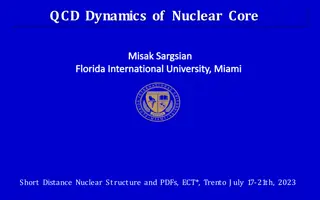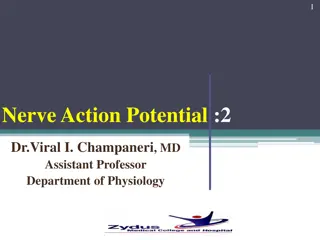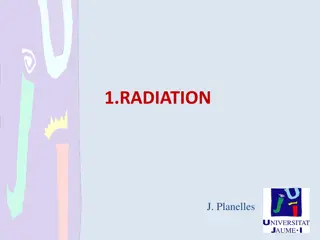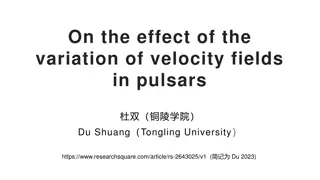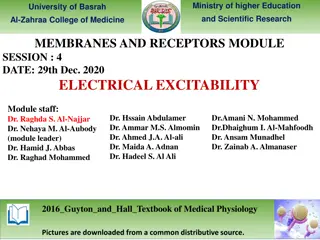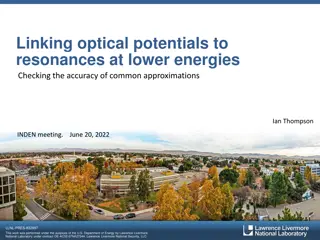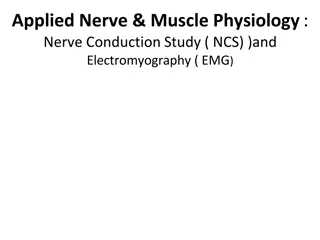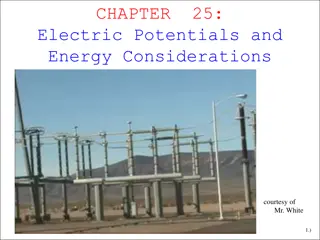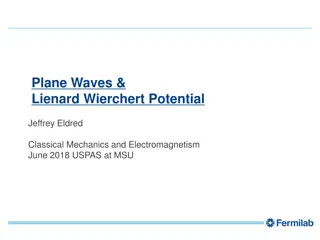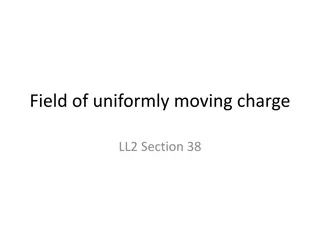
Understanding Potentials and Fields in Electromagnetism
Discover the formulation of potentials in electromagnetism, the significance of the Coulomb and Lorenz gauges, inhomogeneous wave equations, and the concept of retarded potentials. Learn how scalar and vector potentials are redefined to solve problems in electrostatics and magnetostatics, and their importance in Maxwell's equations. Explore the relationship between potentials and fields in electromagnetic theory.
Download Presentation

Please find below an Image/Link to download the presentation.
The content on the website is provided AS IS for your information and personal use only. It may not be sold, licensed, or shared on other websites without obtaining consent from the author. If you encounter any issues during the download, it is possible that the publisher has removed the file from their server.
You are allowed to download the files provided on this website for personal or commercial use, subject to the condition that they are used lawfully. All files are the property of their respective owners.
The content on the website is provided AS IS for your information and personal use only. It may not be sold, licensed, or shared on other websites without obtaining consent from the author.
E N D
Presentation Transcript
1 Chapter 10. Potentials and fields What you should learn (Griffiths 10.1.2-10.1.3, 10.2): ? = ?? ?? ? = ? ? 1. Potentials in a new formulation ?? ?? ?? ? ? = ?0?0 ? ? = 0 2. The Coulomb gauge and the Lorenz gauge 2? = 1 ?0?; 2? = ?0 ? 3. Inhomogeneous wave equations for V and ? ?? ? ? 4. Retarded time ? ? ? ,?? ? 4??0 ? ? ,?? 1 ? ?,? =?0 ?? , ?? ? ?,? = 4? 5. Retarded potentials ?
2 Chapter 10. Scalar and vector potentials ? ? =1 ? ? = ?? ?0? ?? ?? ?? ? ? = ?0 ? + ?0?0 ? ? = 0 General problem to be solved in E&M: Given ?( r, t)and ? ( r, t), what are the fields ?( r, t)and ?( r, t)? s ? ? = 0 still unchanged, we still define the vector potential ? as earlier in magnetostatics: ? = ? ? However, we cannot keep the old definition of the scalar potential ? = ?? because ? ? 0 any longer But we can play the following trick to redefine ?: or ? ? +?? ? ? = ?? ??= ? , = 0 ? ? ?? ?? ? +?? ??= ?? As ? vanishes, could be written as the gradient of a scalar ? = ?? ?? where V is the new scalar potential ?? ?? NB: if , back to electrostatics ? = ?? ??= 0
3 Scalar and vector potentials ? ? =1 ? ? = ?? ?0? ?? ?? ?? ? ? = ?0 ? + ?0?0 ? ? = 0 ? = ?? ?? ? = ? ? ?? Note that the definitions of the potentials automatically take care of noname sand Faraday s equations In fact, the potentials are defined on basis of these equations: Applying div to ? = ? ?: ? ? = ? ? ? 0 (Identity #9) ? = ?? ?? ? ? = ? ?? ? ?? Applying curl to ??: ?? ? ?? 0(Identity #10) = ?? ?? = ? ? ? = ? ?? ? ? ?? ?? Why bother with the potentials? They become more useful than the fields when charges and currents move around!
4 What about the other two Maxwell s equations? Let s plug ? = ?? ?? ?? into ? ? =1 ? ?? ?? =1 ?0?: ?0? ?? New Poisson s equation: Scalar Laplacian: 2? +? ? ? = 1 2? ?2? ??2+?2? ??2+?2? ?0? ?? ??2 Putting ? = ? ? and ? = ?? ?? ?? ??: ?? into ? ? = ?0 ? + ?0?0 ?? ?? ?2? ??2 Vector Laplacian: ?2? = ( 2??, 2??, 2??) ? ? ? = ?0 ? ?0?0? ?0?0 (Identity 11) ? ? ? = ? ? ? ?2? 2??=?2?? ??2+?2?? ??2+?2?? ??2+?2?? ??2+?2?? ??2+?2?? ??2+?2?? ??2 ?2? ??2 ?? ?? 2??=?2?? ? ? ? ?2? = ?0 ? ?0?0? ?0?0 ??2 2??=?2?? ?2? ??2 ?? ?? = ?0 ? ?2? ?0?0 ? ? ? + ?0?0 ??2
5 Scalar and vector potentials: self-reflection 2? +? ? ? = 1 ?0? ?? ?2? ??2 ?? ?? = ?0 ? ?2? ?0?0 ? ? ? + ?0?0 Two new equations contain all the information in Maxwell s equations: The potentials are defined on basis of noname and Faraday s equations so these two are automatically taken care of The other two Maxwell s equations (Gauss and Amp re-Maxwell s laws) recast into the two equations above Profit!!! we have reduced 6 problems (3x ? + 3x ?) to 4 (1x? + 3x ?) But the new equations ARE ugly !!! The good news is that the potentials are not defined uniquely so that we can impose extra conditions on ? and ? to simplify the equations These are called gauge transformations
6 Gauge transformations theorem Potentials are not defined uniquely! Gauge transformations theorem: For any scalar function ( r, t), we can add ? to ? and simultaneously subtract ? /?? from V: ? = ? + ? ; ? = ? ? ?? and this operation will not affect the physical quantities ? and ? Proof: ? = ? ? ? = ?? ?? = ? ? + ? ? = ???? #10:? ? = 0 = ? ? = ? = ?? + ?? ?? ?? ?? ? ? = ?? ?? = ? ?? ?? ?? General proof: Section 10.1.2
7 The Coulomb gauge In magnetostatics, we picked (aka the Coulomb gauge) ? ? = 0 2? +? ? ? = 1 2? = 1 ?0? became Poisson s equation ? ?0? ?? 4??0 ? r ,? 1 ?? ? r,? = We already know the solution (Ch.2.3): (assuming that ? = 0) ? ? There is a very peculiar thing about the scalar potential in the Coulomb gauge: it is determined at point r by the distribution of charge right now (i.e. at the time ?) - but no message travels faster than c ! The point is that V by itself is not a physically measurable quantity but ? is, and ? involves ? as well ? ?? r ?2? ??2 ? = ?? ?? ?? ?? ? = ?0 ? ?? with ?2? ?0?0 ? ?0?0 ? = ? r Whereas V instantaneously reflects all changes in ?, the combination ?? ??/?? does not ? will change only after sufficient time has elapsed for the "news" to arrive
8 The Lorenz gauge Let s do a bit of transformations over the equations for potentials ?? ?? Now we pick ? ? = ?0?0 It s called the Lorenz gauge 2? +? ? ? = 1 ?0? NB1: Not Dutch H.A. Lorentz, but Danish L.V. Lorenz NB2: In case of the static scalar potential, Coulomb and Lorenz gauges become identical 2? 1 ?2 ?2? ??2= ?0 ? ?? ?2? ??2 ?? ?? = ?0 ? ?2? ?0?0 ? ? ? + ?0?0 ?2? ??2= 1 ?0? with ?0?0=1 ?2? ??2+ ?0?0 ?2? ??2 ?2? ??2+? ? ? = 1 2? ?0?0 ?2 ?0? ?2? 1 ?? ?2 ?? ?? = ?0 ? Both ?and ? satisfy the inhomogeneous wave equation with the source term (? and ?) on the right ?2? ?0?0 ? ? ? + ?0?0 ?2 ??2 2 2 1 d'Alembertian operator: ?2? ??2 +? ?? ?? = 1 ?2 2? ?0?0 ? ? + ?0?0 ?0? ?? 2? = 1 ?0?; 2? = ?0 ? ?2? ??2 ?? ?? = ?0 ? ?2? ?0?0 ? ? ? + ?0?0 So electrodynamics is reduced to solving these equations
9 Retarded potentials 2? = 1 In the static case ?0?; ?2? = ?0 ? 4??0 ? ? 2? = 1 ?0?; 2? = ?0 ? ? ? ? ? ?,? at ? 1 ? ? =?0 with the familiar solutions ?? , ?? ? ? = 4? ? In the nonstatic case ? What matters is the condition of the source at some earlier time ?? ?? ? ? when the "message" left the retarded time ? ? ? ??? at ??= ? ? The generalized solutions are called retarded potentials ? ? ? ,?? ? 4??0 ? ? ,?? 1 ? ?,? =?0 ?? , ?? ? ?,? = 4? ? ? ? = ? r All sounds reasonable - but surprisingly simple. Are we sure it's right? We didn't actually derive the formulas for V and ?; we invoked a heuristic argument ("electromagnetic news travels at the speed of light") to make them seem plausible. Homework: prove the retarded potentials
10 Prove for the retarded potential ? ?,? 4??0 ? ? ,?? ?2 ??2? = 1 1 satisfies the inhomogeneous wave equation ?? 2 ?0?0 ? ?,? = ?0? ? Important! In calculating the Laplacian, the crucial point to notice is that the integrand depends on ? in two places: explicitly, in the denominator (? = ? ? ), and implicitly, through ??= ? ? ?, in the numerator. Thus ?? ? ? 1 1 ?+ ?? 1 ? ?? ?? ?,? = 4??0 ?? ? = 1 ???= ?? ? ? ??? ?? ?=?? ?? =?? ?? ? +?? ?? ? +?? =?? ??? ??? ?? ? +?? ??? ?? ? +?? ? ?? ?? ? ? ? ??? ??? ??? Note that ???= ?? as ? is independent of ? =? ? ? + ? ? + ? ? ?2+ ?2+ ?2 1/2 ? ?? ? ?? ? +? = ? ?2+ ?2+ ?2 1/2 ? + = ? = ?? ? ?? ? ?2 3 2= ? ? ? + ? ? + ? ? ?2+ ?2+ ?2 1 ? ? ?? ? ?? ? +? ?3= ?2+ ?2+ ?2 1/2 ? + ?= ? = ?? ? ? ? ? ?2?? 1 ? ? ? ? ?,? = 4??0 Next calculate the divergence of ?? ?,?
11 Prove for the retarded potential ? ?,? ?? ?,? ? ? ? ? ? ? ? ?2 ?? ?? 1 ? ? ?2 4??0 1 1 ? ?? 2? ?,? ?? ? ? ? ? ?2?? 1 ? ? = = 4??0 ? ? ? ? =1 ? ? ? ? ? ? = 1 ? ?? = 1 =1 ? ? ? ? ?; (As ?? before) ? ? ? before) ? ??? ?2 ?2 ? ? (?? = (Prob. 1.63) ? ?2 ?? = ? ? ? ?2 ? ?? ? ? 1 ? ? ? ? = ? ? ?2 ? ?= = Prob. 1.63 = = ???; ?? ? ?2 ? ?2 Cancel = 4??3? = 4???3? ? Eq.1.100 ; ?? 1 1 ?2 ? ? 4???3? =1 1 ? ??? 1 2? ?,? = ?? 4??0 4??0 ?0? ?2 ?2? ??2= 1 ? ??? 4??0 ?2 ??2? =1 1 ? ??? 1 ?0? 1 1 ? ??? = 1 2 ?0?0 4??0 4??0 q.e.d. ?0? ?2 ?2 Homework: check that the retarded potentials obey the Lorenz gauge (Problem 10.10)
?? ?? ? Why is it possible to define the Lorenz gauge as ? ? = ?0?0 12 ?? ?? so that ? ? + ?0?0 ?? ??= Suppose that ? ? ?0?0 ? = ? + ? ; ? = ? ? We want to pick such that ? and ? in ?? ?? ??= 0 do obey ? ? + ?0?0 How to pick? ?? ?? ?2 ??2 ?2 ??2 ?? ?? ?0?0 ?? ??+ 2 ?0?0 ? ? + ?0?0 = ? ? + 2 + ?0?0 = ? ? + ?0?0 + 2 So that if we pick for the solution to 2 = (which we know how to solve!), + 2 = 0 and ?? ??= 0 ? ? + ?0?0 See Problem 10.6
13 Lecture 30. Potentials and fields (1/2). Radiation (1/2) What you should learn (Griffiths 10.2): ? ? ,?? ? 4??0 ? ? ,?? 1 ? ?,? =?0 1. Retarded potentials ?? , ?? ? ?,? = 4? ? ?? ? ? ? ? ? ? ,?? ?? ?( ? ,??) ?2 ??( ? ,??) ?? 1 1 1 ?? ? + ? ?( ?,?) = 4??0 ?2? ?? 2. Efimenko s equations ? ? ,?? ?2 ? ? ? ,?? ?? ?( ?,?) =?0 1 ? ?? 4? + ?? ? ? 3. How slow is slowly enough ? ?
14 Jefimenko s equation for ?( ?,t) and ?( ?,?) If you apply the logic of retarded time to the fields, you'll get the entirely wrong answer: ?? ? ? ? ? ,?? ? ?2 4??0 ? ? ,?? 1 ? ?,? ?0 ? ?? , ?? ? ?,? 4? ? ?2 BTW, this is why in electrodynamics we prefer to deal with the potentials rather then with the fields But you can find the fields ? and ? from the retarded potentials as ? = ?? ?? ??and ? = ? ? ? ? ? ,?? ?? ?( ? ,??) ?2 ??( ? ,??) ?? 1 1 1 Time-dependent generalization of Coulomb's law ?? ? + ? ?( ?,?) = 4??0 ?2? ?? ? ? ,?? ?2 ? ? ? ,?? ?? Time-dependent generalization of the Bio- Savart law ?( ?,?) =?0 1 ? ?? 4? + ?? The equations were first obtained by Oleg Jefimenko in 1966 (Homework: Chapter 10.2.2 and two slides at the end)
15 How slow is slowly enough? ? ? ,?? ?2 ? ? ? ,?? ?? ?( ?,?) =?0 1 ? ?? 4? + ?? Let s request the time-dependent term be much smaller than the previous one: ? ? ?? ? 1 This is the quasistatic approximation ?2 ?? 1 ? ?? ?? ? The rate of the relative change of the current is much smaller than the time it takes to get to the observation point ? ,or ? ? ,or ? ? ?0?????? ?0???? ? ? 2?? 3 108 2? 5 109 1 cm 1 (It is called the near zone) Suppose ? = ?0????: ? ? ? =3 108 2? 50 106 m For ? = 50 Hz,? -- quasistatic approximation doesn t work in a computer For ? = 5 GHz,? We just answered a long-standing question in the course of E&M: The quasistatic approximation can be safely used for many problems which do not involve either long distances or high frequencies as we did many times before
16 YouTube resources Youtube lectures by Jonathan Gardner: https://www.youtube.com/playlist?list=PLDDEED00333C1C30E Scalar and vector potentials: https://www.youtube.com/watch?v=gc8NvnlMawY Gauge transformations: https://www.youtube.com/watch?v=7du0vyQ99mQ The Coulomb gauge: https://www.youtube.com/watch?v=saX9EVKx82E Lorentz gauge: https://www.youtube.com/watch?v=MAz1eo-Zwjk Retarded potentials: Part 1/3 https://www.youtube.com/watch?v=G4MdRbV-bgU Part 3/3 https://www.youtube.com/watch?v=z9lC1rGLqDo&t=0s Part 3/3 https://www.youtube.com/watch?v=0TXS9A6tjK4&t=49s
17 Extra Derivation of Jefimenko s equation for ?( ?,t) ? ? ,?? ? 4??0 ? ? ,?? Let s find the field ? = ?? ?? 1 ? ?,? =?0 ?? , ?? ?? from ? ?,? = 4? ? ? ? ? ? ?2?? 1 ? ? (was already calculated a few slides earlier) ?? ?,? = 4??0 ? ? ,?? ? ? ? ??? ? ? ,?? ? ? ? ? ,?? ??? 1 ??? ???? =?0?0 =?0 4? 1 ?? ?,? ?? ?? ,where ? ?? = 4??0?2 4??0 ? ? ? ,?? ?2? ?( ? ,??) ?2 ? ( ? ,??) ?? 1 ?? ? + ? ?( ?,?) = 4??0
18 Extra Derivation of Jefimenko s equation for ?( ?,t) ?? ? ? ? ? ,?? ? ? ?,? =?0 ?? 4? ? ? ?? ?? ?? ? ?? ?? ?? ? ?? ?? ?? Let s find the field ? = ? ? Rule #7 1 ? 1 ? 1 ? ? =?0 1 ? 1 ? ? ? ? ? ?? 4? ?=1 =1 ??? ?? ??? =??? ??? ??? ??= ?? 1 ?? ?? ?? 1 ?? ?? ?? ??? ? ??=??? ? ? ? ?? ? ? ??? ? ? ?? ? ? ? =1 ? ?2 1 ? ? ?; ? = ? ? ? ,?? ?2 ? ? ,?? ?? ?( ?,?) =?0 ? ?? 4? + This is the time-dependent generalization of the Bio-Savart law
19 Extra From Jefimenko sto Coulomb s for ?( ?,t) ? ? ? ,?? ?? ?( ? ,??) ?2 ??( ? ,??) ?? 1 1 1 ?? ? + ? ?( ?,?) = 4??0 ?2? ?? Let s suppose ? = ????? in time (magnetostatics approximation), so that ? = 0 and the 3rd term = 0 Let s expand ? ,?? into Taylor s series around ??= 0 (???= ?? as ? is independent of ?): ? ,0 +? ? ,0 ? ,?? = ? ,??= 0 +? ? ,??= 0 ??( ? ,??) ??? ??? 1 4??0 ?? ??+ ??? ??? =??( ? ,0) ?? ? ? ? ,0 ?2 ? ? ,0 ??? ??( ? ,0) ??? 1 1 ? ? ?? ? ?,? = + ??+ ?2 ?? ? ,? 4??0 ? ,? ?2 ? ,0 +? ? ,0 ? ? ,0 ??? ??( ? ,0) ??? 1 1 1 1 ? ?+ 1 ? ?? ??? = = 4??0 ? ?2 ?2 ?? ?? This is Coulomb's law with ? = ????? and the charge density evaluated at the non-retarded time The static approximation works much better than we had any right to expect: the two errors involved (neglecting retardation and the time-dependent term ??( ? ,??) ) cancel one another ???
20 Extra From Jefimenko s to Bio-Savart s for ?( ?,?) ? ? ,?? ?2 ? ? ? ,?? ?? ?( ?,?) =?0 1 ? ?? 4? + ?? ? ? ,?? = ? ? ,? +? ? ? ,? Let s expand ? ? ,?? into the Taylor series around ??= ?: ?? ? + ??? Suppose the current density changes slowly enough that we can ignore all higher derivatives ? ? ,?? ? ? ,? +? ? ? ,? ??? ?? ? ? ? = ? ? ,? ? ? ? ,? ? ? ?? ? ??? ?? ? ? ? ? ? ,?? ??? =? ? ? ,? ? ??? ? ? ,? ?2 ? ? ,? ? ?2 ? ? ? ,? ??? ? ? ? ,? ??? =?0 4? ?( ?,?) =?0 1 ? ?+ 1 ?? ? ?? 4? ?2 ?? This is the Bio-Savart law with the current density evaluated at the non-retarded time The quasistatic approximation is actually much better than we had any right to expect: the two errors involved (neglecting retardation and the time-dependent term ? ? ? ,?? This lends strong support to the quasistatic approximation used by us earlier ) cancel one another ???
21 Extra How slow is slowly enough? Another approach ? ? ,?? = ? ? ,? +? ? ? ,? ?? ? + ??? For the Taylor series to converge, we need to request the next term be smaller than the previous one: ? ? ? ,? ??? ? ? ,? This is the quasistatic approximation ?? ? The rate of the change of the relative change is much smaller than the time it takes to get to the observation point ?? ?? ? ? 1 ? ?? ?? ? ? ; ? ,or ? ? ,or ? ? ?0?????? ?0???? ? ? 2?? 3 108 2? 5 109 1 cm 1 (It is called the near zone) Suppose ? = ?0????: ? ? ? =3 108 2? 50 106 m For ? = 50 Hz,? -- quasistatic approximation doesn t work in a computer For ? = 5 GHz,? We just answered a long-standing question in the course of E&M: The quasistatic approximation can be safely used for many problems which do not involve either long distances or high frequencies as we did many times before

